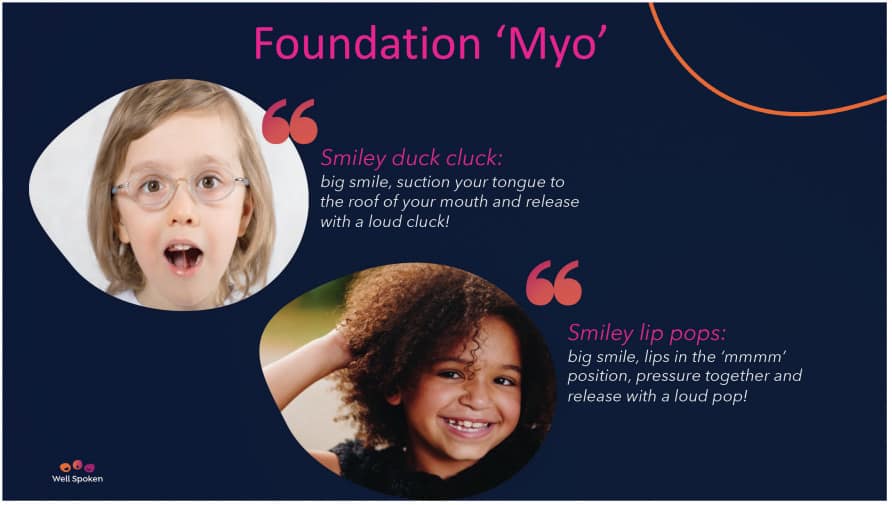Sharon Moore shows how myofunctional therapy for children can help avert a sleep crisis.
 by Sharon Moore
by Sharon Moore
In part three of this four-part series, author, speech pathologist and myofunctional practitioner Sharon Moore shares critical information about the role of myofunctional therapy in the management of pediatric sleep disordered breathing. Previously, we looked at how dental clinics can screen for sleep disordered breathing for early treatment, with the goal of addressing problems well before children start school.
In this article, we will look at the role of myofunctional therapy in building and maintaining a healthy airway in a proactive, family-friendly way.
Four-year-old Daniel had turned into a monster. Daniel had been a poor sleeper from birth. He refused to go to bed, woke his parents frequently, and only had seven hours of sleep a night (instead of the recommended 10-13 hours for his age). He never slept for more than two hours at a stretch and wouldn’t take naps in the day.
Like many sleep-deprived kids, every day Daniel would hit the ground running, reacting to sleep deprivation with over-activity, which the body craves as compensation for poor sleep. Not only that, but Daniel had an explosive temper and was extremely defiant.
After two years of Daniel’s irrational meltdowns, and seeing 23 specialists in Australia and the US, his parents were at a breaking point (and so was their marriage). It wasn’t until a dentist recognized an airway/breathing issue in a routine check-up, that they were referred to me.
After six months of medical, dental, and myofunctional therapy (myo) treatments, Daniel was a brand-new kid; he was breathing and eating well with no more snoring or tantrums, and he had a big growth spurt. His improvement was measurable on the Sleep Disturbance Scale for Children,1 where his scores almost halved from ninety-nine in March 2016 to fifty in December 2016, placing him in the normal range.
The 3 Biggest Problems for Parents of Sleep-wrecked Kids
As a speech pathologist diagnosing and treating “things that go wrong in the upper airway”, I’ve seen first-hand how sleep problems interfere with kids’ health, communication, and family happiness.

Unfortunately, many sleep-breathing problems are missed, dismissed, or misdiagnosed. While parents may notice symptoms, many assume they are normal, or they might be so busy they focus on quick fixes rather than addressing underlying issues. Additionally, sleep is such a specialized area of medicine that many doctors don’t know how to address it.
Dentists are on the Front Line
Dentists are in the best position to screen for, educate on, and treat problems like sleep disordered breathing (SDB), given that they work face-to-face with families and children.
- For parents seeing symptoms but not recognizing them, dentists can provide educational guides and screening.2,3
- For parents focused on quick fixes, dentists can give feedback on the best treatment options: medical, dental, myo or all three.4-6
- For parents needing medical or dental expertise, dentists can refer them to a network of likeminded professionals.7-11

What Leads to Poor Upper Airway Patency?
You have far more influence over the shape and development of children’s airway health than you might believe.12
Aside from clearly diagnosable medical conditions, syndromes, and craniofacial anomalies, there are many non-syndromic children developing airway issues.13 This is often due to shifts in modern-day life leading to changes in how children’s faces, mouths, and airways develop.
The way we use the muscles for sucking, swallowing, breathing, and chewing – especially in our early years – has a big impact on breathing during sleep, and subsequently sleep quality.14 Our jaws rely on optimal muscle function to grow and develop. For this reason, it’s important to ensure children learn to use these muscles correctly.15 If sub-optimal muscle use is not fully treated, recurrence or development of SDB is even possible later in life.16

Myo: The Secret Weapon to Fighting the Sleep Crisis?
There are multiple studies demonstrating the crucial role of myofunctional therapy (myo) in the management of SDB. A recent study shows that Apnea-Hypopnea Index can be reduced by 43% in children with myofunctional therapy.17 Other studies support this premise.18-23
This tells us sleep breathing problems are both treatable and avoidable.
There are two ways we use myo in our clinic:
- Myo optimize programs for children, like a fitness program for the mouth, face, and throat.
- Myo correct for addressing existing issues, which entails functional assessment, diagnosis, and corrective treatments.
The ultimate aim is for ‘myo fitness’ to be a part of everyday life.

Who is ‘Qualified’ to do Myofunctional Therapy?
There is almost always a role for a well-trained and experienced myofunctional practitioner in managing a child’s upper airway health. Protocols and the body of knowledge in myofunctional science are rapidly growing. It is a sub-specialty for existing health professionals, including speech language pathologists, occupational therapists, physical therapists, and dental hygienists. With telehealth, myo has become accessible to all, opening potential global partnerships with experienced practitioners.

Why Wait for Great Sleep?
Left untreated, poor breathing, sucking, chewing, and swallowing habits may lead to shape changes in face and jaws that go on to shape the adult face, jaws and airway, predisposing children to SDB for life. Consequently, proactive early intervention is the key. If we tune into these problems well before children start school, they can recover from deficient or poor growth and development patterns into a typical growth pattern.
When children’s sleep and breathing improves, they are happy, alert and better behaved within days. Having a healthy airway from a young age can save a lot of trouble later.
Dental hygienists are an integral part of recognizing myofunctional disorders and helping to start the child on the path to myofunctional therapy. Read more here: https://dentalsleeppractice.com/practice-management/dental-hygienists-becoming-myofunctional-therapists-part-of-the-dental-team/
- Oliviero Bruni, Salvatore Ottaviano, Vincenzo Guidetti, Manuela Romoli, Margherita Innocenzi, Flavia Cortesi and Flavia Giannotti, ‘The Sleep Disturbance Scale for Children (SDSC): Construction and Validation of an Instrument to Evaluate Sleep Disturbances in Childhood and Adolescence’, Journal of Sleep Research 5, no. 4 (1996): 251–61, https://doi.org/10.1111/j.1365-2869.1996.00251.x.
- Sharon Moore, Sleep-Wrecked Kids: Helping Parents raise happy healthy kids one sleep at a time. (New York: Morgan James publishing 2019).
- Sharon Moore, ‘Well Slept Kids’, guides for parents, in press, to be released 2021, queries: projects@wellspoken.com.au
- Guilleminault and Huang, ‘From Oral Facial Dysfunction to Dysmorphism and the Onset Of Pediatric OSA’
- Christian Guilleminault, ‘A Case for Myofunctional Therapy as a Standard of Care for Pediatric OSA’, in The2nd AAMS Congress (Chicago, 2017).
- Guilleminault, Christian, et al. “Teenage sleep-disordered breathing: recurrence of syndrome.” Sleep medicine 14.1 (2013): 37-44.
- AAPMD: American Academy of Physiological Medicine and Dentistry, https://www.aapmd.org
- TBI: The Breathe Institute, https://www.thebreatheinstitute.com
- AAMS: Academy of Applied Myofunctional Sciences, https://aamsinfo.org
- IPOS: The International Pediatric Orthodontic Society, https://iposinfo.org/contact/, https://fr.iposinfo.org
- IAOM: International Association of Orofacial Myology, https://www.iaom.com
- Sharon Moore, Sleep-Wrecked Kids: Helping Parents raise happy healthy kids one sleep at a time. (New York: Morgan James publishing 2019).
- Linda D’Onofrio, Oral dysfunction as a cause of malocclusion, Orthod Craniofac Res. 2019;22(Suppl. 1):43–48, DOI: 10.1111/ocr.12277
- Christian Guilleminault and Yu-Shu Huang, ‘From Oral Facial Dysfunction to Dysmorphism and the Onset Of Pediatric OSA’, Sleep Medicine Reviews, 2017, https://doi.org/:10.1016/j. smrv.2017.06.008.
- Christian Guilleminault, ‘A Case for Myofunctional Therapy as a Standard of Care for Pediatric OSA’, in The 2nd AAMS Congress (Chicago, 2017).
- Guilleminault, Christian, et al. “Teenage sleep-disordered breathing: recurrence of syndrome.” Sleep medicine 14.1 (2013): 37-44.
- Anuja Bandyopadhyay, Kellie Kaneshiro, Macario Camacho Effect of myofunctional therapy on children with obstructive sleep apnea: a meta-analysis, Sleep Medicine, Volume 75, November 2020, Pages 210-217, https://doi.org/10.1016/j.sleep.2020.08.003
- Macario Camacho, Victor Certal, Jose Abdullatif, Soroush Zaghi, Chad M. Ruoff, Robson Capasso and Clete A. Kushida, ‘Myofunctional Therapy to Treat Obstructive Sleep Apnea: A Systematic Review and Meta-analysis’, Sleep 38, no. 5 (2015), https://doi.org/10.5665/sleep.4652.
- Camila De Castro Corr.a and Gi.dre Berretin-Felix, ‘Terapia miofuncional orofacial aplicada. S.ndrome do aumento da resist.ncia das vias a.reas superiores: caso cl.nico’, CoDAS 27,no. 6 (2015), https://doi.org/10.1590/2317-1782/20152014228.
- Guilleminault, Y. S. Huang, P. J. Monteyrol, R. Sato, S. Quo and C.H. Lin, ‘Critical Role of Myofascial Reeducation in Pediatric Sleep-Disordered Breathing’, Sleep Medicine 14, no. 6 (2013), https://doi.org/10.1016/j.sleep.2013.01.013.
- Huang and Guilleminault, ‘Pediatric Obstructive Sleep Apnea and the Critical Role of Oral-Facial Growth: Evidences’
- Macario Camacho, Christian Guilleminault, Justin M. Wei, Sungjin A. Song, Michael W. Noller, Lauren K. Reckley, Camilo Fernandez-Salvador and Soroush Zaghi, ‘Oropharyngeal and Tongue Exercises (Myofunctional Therapy) for Snoring: A Systematic Review and Meta-Analysis’, European Archives of Oto-Rhino-Laryngology, 2017, https://doi.org/10.1007/s00405-017-4848-5.
- Maria Pia Villa, Melania Evangelisti, Susy Martella, Mario Barreto and Marco Del Pozzo, ‘Can Myofunctional Therapy Increase Tongue Tone and Reduce Symptoms in Childrenwith Sleep-Disordered Breathing?’ Sleep and Breathing 21, no. 4 (2017), https://doi.org/10.1007/s11325-017-1489-2.
 Sharon Moore is an author, speech pathologist and myofunctional practitioner with 40 years of clinical experience across a range of communication and swallowing disorders. Sharon has a special interest in early identification of craniofacial growth anomalies in children, concomitant orofacial dysfunctions, and airway obstruction in sleep disorders.
Sharon Moore is an author, speech pathologist and myofunctional practitioner with 40 years of clinical experience across a range of communication and swallowing disorders. Sharon has a special interest in early identification of craniofacial growth anomalies in children, concomitant orofacial dysfunctions, and airway obstruction in sleep disorders.